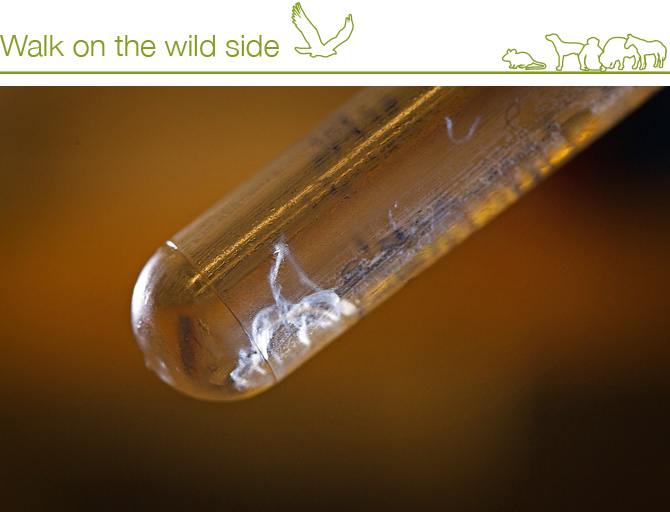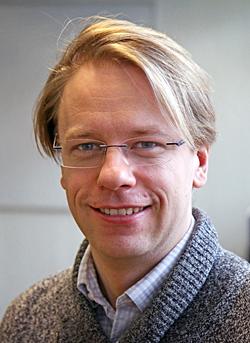Animals inspire innovations in science and engineering
Furry airplanes, submarines modeled after penguins and wind turbine blades based on whale fins. KTH research is replete with examples of inspiration from the animal kingdom.

The technique biomimetics aims to solve problems and create new products by mimicking the way nature and animals do things.

And like the animals themselves, examples of biomimetics continue to multiply. By studying termite mounds and their ventilation system, it has been possible to imitate them and design large buildings without air conditioning.
Bombardier beetles spray a hot, noxious chemical when frightened, providing an idea for spray bottles for fuel injection in engines.
Polar bear fur has inspired new insulation material, and blue mussels' ability to stick to objects has been used to make paint for ships and glues that replace surgical thread.
The list goes on.
A remarkable number of examples from the animal world have a clear connection to fluid dynamics, says Fredrik Lundell, senior lecturer at the Department of Mechanics at KTH. He does research on fluid physics and is involved in interdisciplinary studies of how bio-based materials can be created with nanocellulose from trees.
Nature is full of amazing flow solutions, he points out. "Take the Gurney flap, for example. These are located at the rear of a racecar and press the vehicle down on the road through what is called downforce," Lindells says. "This allows the car to run faster on the curves, and the inspiration for it comes from dragonfly wings.
"Scores of studies have also been done on sharks' and rays' skin. Scientists have looked at rays' ribs, and studied what enables the shark to swim fast over long distances," he says.
In his work to create new materials, Lundell and his colleagues have taken their search to the forest, where their biomimetics study focuses on trees.

"What trees and plants, as well as spiders, all have in common is that they are composed of — or can produce — fibres that are well-structured. Researchers at KTH have broken apart these wood fibres into nano-crystals, which have been reassembled into a strong thread," Lundell says.
"The nanostructure of the thread is not in exactly the same order as in the trees, but the material is just as strong or stronger".
The resulting material can then be used in textile or fibre composites, for example in wind turbine blades or bumpers on cars.
But plants aren't the only source of durable material. The silk produced by spiders is regarded as one of nature's strongest materials. Many researchers dream of finding a way to reproduce this material artificially, and at KTH, My Hedhammar and her colleagues have found a way. They achieve this with the help of a miniature version of the proteins the spider itself uses — spidroins.
The researchers don't work directly with the creatures anymore, she says. "We're past that stage. Now we are working to create new materials with spidroins. This includes, among other things, recreating human tissue, that is, regenerative medicine."
One of the things the researchers are working on is using spider silk as a kind of scaffolding for gluing cells into human tissue. It is about building in three dimensions, instead of joining individual cells, she says.

The protein can also act as a sort of glue to affix other proteins, such as antibodies, upon a surface so that complex samples can be analyzed, as in medical diagnostics, where the presence of a certain type of antibody in a blood sample must be measured carefully.
Hedhammar says that when it comes to trying to build human tissue, biomimetics is here to stay. However, there is much work to do. You cannot select or isolate a subset of conditions and expect it to work, she says.
"You can't simplify things as much as you might want to. Natural phenomena are complex, not least when it comes to regenerative medicine."
Hedhammar is hardly the only one at KTH to study animals in detail. Shervin Bagheri, a researcher at the Linné Flow Centre, has studied flexible objects such as animal fur and their relation to air and water, and he and his colleagues have made a discovery. Animals rely greatly on their tails to move forward. A positive interaction between the tail and the surrounding air or water contributes to the animal's movements. But this requires some effort from the animal.
The fact is that one of the many functions of tails, feathers, scales, hair and other elastic and malleable growths in animals is to increase the creature's ability to move around in the air and water.
Does this mean that tomorrow's cars were equipped what resembles a squirrel's bushy tail? Or will aircraft in the future sport a beautiful thick coat?
According to Bagheri one consequence could be that aircraft manufacturers will attach flexible structures on the aircraft, in order to reduce fuel consumption. Some research remains to be done before we are there.
Peter Larsson

